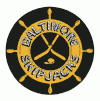Baltimore Skipjacks
The Skipjacks reached the Calder Cup finals in the 1984–85 AHL season, but were defeated by the Sherbrooke Canadiens.
Mitch Lamoureux is the Skipjacks career leader in goals (119), assists (133), and points (252), and was inducted into the AHL Hall of Fame.
[1] The Eastern Hockey League (EHL) granted the Advocates an expansion team on September 12, 1979, which revived the Baltimore Clippers name.
The newest Clippers played in the EHL for two seasons, and were affiliated as a farm team of the Minnesota North Stars of the National Hockey League from 1979 to 1981.
Spectators were excited by fighting between the teams and threw beer and other debris onto ice surface, which resulted in injuries and at least one arrest.
Advocates' president John Haas stated the ACHL was set up "primarily to pay the financial obligations" of the EHL.
[1] The Advocates also rebranded the team to Baltimore Skipjacks, to avoid paying US$10,000 in trademark rights for the Clippers' name.
[21] Mitch Lamoureux led the league with 57 goals,[24] and won the Dudley "Red" Garrett Memorial Award as the AHL Rookie of the Year.
[22] The Skipjacks unveiled a new logo for the season (shown in infobox) which resembled the word "JACKS" superimposed on a ship's wheel, and used the same black, gold and white color scheme of the Penguins.
[28] Ubriaco was brought back as head coach, and led the team to its best record with 102 points, and 384 goals scored.
[29] The Skipjacks won the John D. Chick Trophy as the regular season champions of the AHL's south division.
[30][31] The offense was evenly spread out, with 18 different players scoring at least 10 goals, and Paul Gardner led the team with 81 points.
[38] However, they were a more defensive oriented team than previous seasons, conceding only 252 goals, while scoring 326, and finishing second place in the south division with 98 points.
[39] The defense was led by captain Steve Carlson,[3] and goaltender Jon Casey, on loan from the Minnesota North Stars.
[42] The Skipjacks' offense was shut down in the finals by rookie 19-year-old goaltender Patrick Roy, and the team lost in six games to the Sherbrooke Canadiens.
[3][18] The Skipjacks began the season with sixteen consecutive losses, and finished last in the AHL with 35 points, missing the playoffs.
[22] The Skipjacks logo was switched to a red, white and blue color scheme to match the Washington Capitals.
[28] Terry Murray was appointed the new head coach, and improved the team record to 30 wins, but the Skipjacks missed the playoffs for a fourth consecutive season.
[50] The Skipjacks began the 1989–90 AHL season with a 26–17–2 record, before head coach Terry Murray was promoted to the NHL, and replaced by Doug MacLean.
[51] Goaltender Jim Hrivnak won 24 games, and earned four shutouts, and Mike Richard led the team in scoring again with 41 goals, and 83 points.
Washington also allocated the Hampton Roads Admirals of the East Coast Hockey League, as a farm team for the Skipjacks.
[29] The offense was led by John Byce with 35 goals, and 79 points, and goaltender Byron Dafoe played 48 of 80 games.



